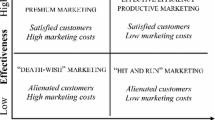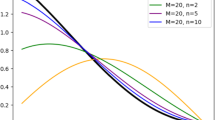Abstract
We formulate a stochastic extension of the Nerlove and Arrow’s advertising model in order to analyze the problem of a new product introduction. The main idea is to introduce some uncertainty aspects in connection both with the advertising action and the goodwill decay, in order to represent the random consequences of the advertising messages and of the word-of-mouth publicity, respectively. The model is stated in terms of the stochastic optimal control theory and a general study is attempted using the stochastic Maximum Principle.
Closed form solutions are obtained under linear quadratic assumptions for the cost and the reward functions. Such optimal policies suggest that the decision-maker considers both the above mentioned phenomena as opportunities to increase her/his final reward. After stating some general features of the optimal solutions, we analyze in detail three extreme cases, namely the deterministic model and the stochastic models with either the word-of-mouth effect only, or the lure/repulsion effect only. The optimal policies provide us with some insight on the general effects of the advertising action.
Similar content being viewed by others
References
Ait Rami M., Moore J.B. and Zhou X.Y. (2001). Indefinite Stochastic Linear Quadratic Control and Generalized Differential Riccati Equation.SIAM Journal on Control and Optimization 40, 1298–1311.
Bensoussan A. (1992).Stochastic Control of Partially Observable Systems. Cambridge University Press.
Buratto A. and Viscolani B. (1996). Advertising for the Launch of a Product with Random Success.Ricerca Operativa 26, 45–62.
Buratto A. and Viscolani B. (2002). New Product Introduction: Goodwill, Time and Advertising Cost.Mathematical Methods of Operations Research 55, 55–68.
Chen S., Li X. and Zhou X.Y. (1998). Stochastic Linear Quadratic Regulator with Indefinite Control Weight Costs.SIAM Journal on Control and Optimization 36, 1685–1702.
Feichtinger G., Hartl R.F. and Sethi S.P. (1994). Dynamic Optimal Control Models in Advertising: Recent Developments.Management Science 40, 195–226.
Jørgensen S., Taboubi S. and Zaccour G. (2001). Cooperative Advertising in a Marketing Channel.Journal of Optimization Theory and Applications 110, 145–158.
Jørgensen S. and Zaccour G. (1999). Equilibrium Pricing and Advertising Stategies in a Marketing Channel.Journal of Optimization Theory and Applications 102, 111–125.
Nerlove M. and Arrow J.K. (1962). Optimal Advertising Policy under Dynamic Conditions.Economica 29, 129–142.
Raman K. (1990). Stochastically Optimal Advertising Policies under Dynamic Conditions: the Ratio Rule.Optimal Control Applications and Methods 11, 283–288.
Rao R.C. (1986). Extimating Continuous Time Advertising-Sale Models.Marketing Science 5, 125–142.
Sethi S.P. (1990). Deterministic and Stochastic Optimisation of a Dynamic Advertising Model.Optimal Control Applications and Methods 4, 179–184.
Tapiero C.S. (1975). On-line and Adaptive Optimum Advertising Control by a Diffusion Approximation.Operations Research 23, 890–907.
Tapiero C.S. (1978). Optimum Advertising and Goodwill under Uncertainty.Operations Research 26, 450–463.
Tapiero C.S. (1979). A Generalization of the Nerlove-Arrow Model to Multi-Firms Advertising under Uncertainty.Management Science 25, 907–915.
Tapiero C.S. (1982). Optimal Control of a Stochastic Model of Advertising. In: Feichtinger G. (ed.),Optimal Control Theory and Economic Analysis. North-Holland, 287–299.
Tapiero C.S. (1983). Stochastic Diffusion Model with Advertising and Word-of-Mouth Effects.European Journal of Operational Research 12, 348–356.
Tapiero C.S. (1988).Applied Stochastic Models and Control in Management. North-Holland.
Yong J. and Zhou X.Y. (1999).Stochastic Controls, Hamiltonian Systems and HJB Equations. Springer Verlag.
Author information
Authors and Affiliations
Additional information
Supported by MIUR and University of Padua.
Rights and permissions
About this article
Cite this article
Grosset, L., Viscolani, B. Advertising for a new product introduction: A stochastic approach. Top 12, 149–167 (2004). https://doi.org/10.1007/BF02578929
Received:
Accepted:
Issue Date:
DOI: https://doi.org/10.1007/BF02578929




